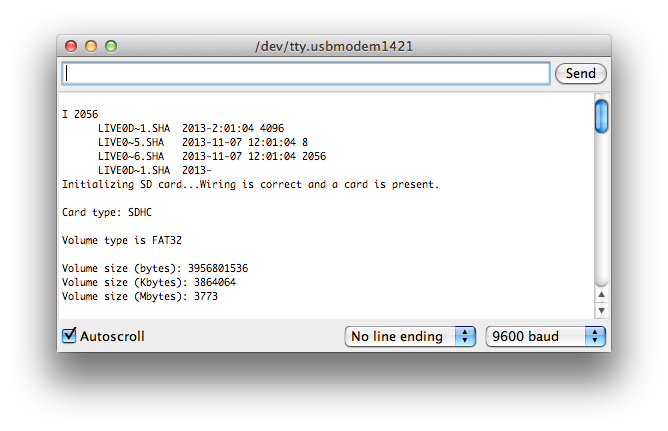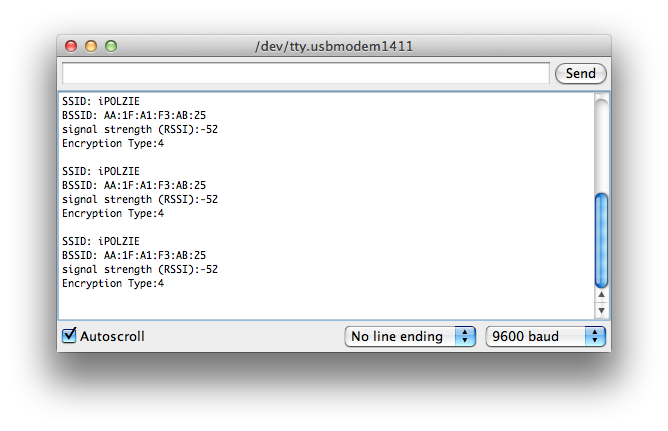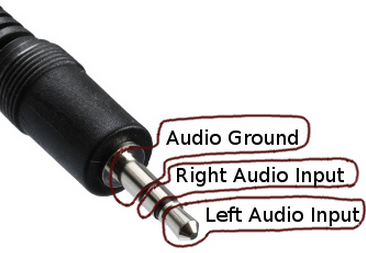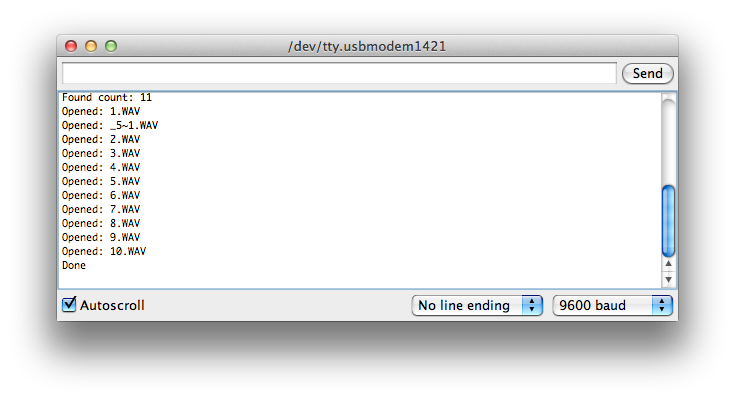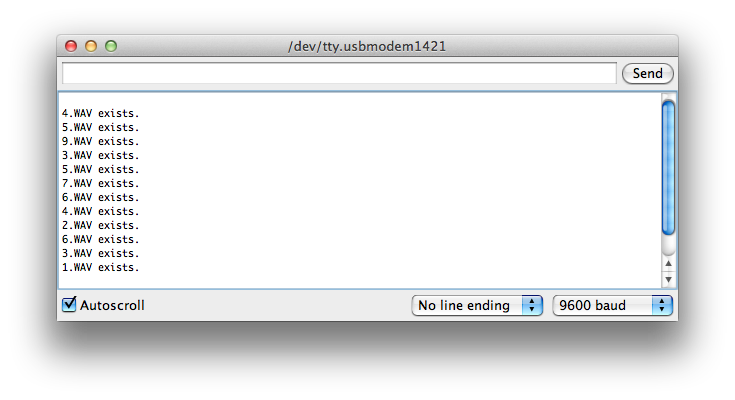Redesigning Sound
From Wikicliki
Contents
- 1 Process
- 2 ACTION PLAN
- 3 Testing the Accelerometer
- 4 Using another accelerometer
- 5 Testing RC Switch
- 6 Testing the SD Library
- 7 Testing the Wifi shield
- 8 Fixing up the Audio Jack
- 9 Combining the accelerometer and the audio
- 10 Libraries
- 11 Connecting Two Arduinos through serial comms - first test
- 12 ARGHH??????
- 13 WORKING 4pm
- 14 Calling up files
- 15 Listing all the files in the SD card (wav format only)
- 16 Picking Random File to play
- 17 End product
- 18 See also
Process
Tutorial with Yuri, 31 oct
- surround haptics - sound / haptic / visual / feedback
- usb sound output for playing back sounds
Guides / Tutorials / Gear
- Build your own diy binaural mic: http://tbug.jp/diybinaural/
- Accelerometer, Gyro and IMU Buying Guide: https://www.sparkfun.com/pages/accel_gyro_guide
- Sound bug - http://www.katronix.webplusshop.com/product.wml/source/RSS/productid/197432
Interesting links
- http://www.nellyben.com/projects/the-international-space-orchestra/
- http://en.wikipedia.org/wiki/Geophone
Brainstorming, 31 oct
Bucket of links
- http://en.wikipedia.org/wiki/Geiger_counter
- http://www.martinluge.de/work/digitalWind/
- http://www.katiepaterson.org/icerecords/
- http://www.the-product.org/
- http://en.wikipedia.org/wiki/Binaural_beats
- http://en.wikipedia.org/wiki/Auditory_illusion
- http://en.wikipedia.org/wiki/Sonification
- http://news.bbc.co.uk/1/hi/england/hampshire/8291720.stm
- http://www.bbc.co.uk/news/technology-23665490
- https://www.youtube.com/watch?v=iwfsFtpACFw
- http://en.wikipedia.org/wiki/Claustrophobia
- dream layers of lift: https://www.youtube.com/watch?v=KpDd7pQRKHI
- http://en.wikipedia.org/wiki/Cymatics
- http://vimeo.com/68768890
- http://laughingsquid.com/hear-heres-giant-ear-trumpet-sculptures-highlight-sounds-of-nature/
- http://www.brainpickings.org/index.php/2010/09/30/837-kilo-ohm-erwin-stache/
- http://www.julianneswartz.com/work_archive/work.php
Tutorial with Mike, 1 nov
- Recommended to use triple axis accelerometer - ADXL362 - already has arduino library written for it
- accelerometer only measures acceleration. think of acceleration in terms of integration, velocity, position...
- with regards to printing our own pcb - can do laser cut or acetate / pcb toner transfer
- sound - look up trigger mp3 with sd card slot
- also think about amplifier and power source
Weekend + Tutorial with Mike and Dave, 4 Nov 2013
- concept - what about instead of using live sound, just use sound that represents the floor - radio waves and their material form - what if it were the opposite and the sound only plays when the door opens. augmented reality.
- how about thinking about lift culture, fantasies about lifts as transportation to different planes and levels of reality, charlie and the chocolate factory, being john malkovich, the lift sighing in the hitchhiker's guide to the galaxy
- what about using baby monitor or walkie talkie
- think about the presentation - video response? sound player? other forms?
- david tudor's rainforest
- whispering lift? a lift that whispers secrets from the outside in
- http://apcmag.com/arduino-project-5-digital-audio-player.htm
- http://maxoffsky.com/maxoffsky-blog/how-to-play-wav-audio-files-with-arduino-uno-and-microsd-card/
- Robersontronics MP3 Trigger board - https://vimeo.com/67617269 - https://www.sparkfun.com/products/11029
- SKU 146706 Micro SD Card Storage Memory Board Module for Arduino (Works with Official Arduino Boards)
- Kingston 8 GB microSDHC Class 4 Flash Memory Card SDC4/8GBET
- http://australianrobotics.com.au/catalog/batteries-and-power
- http://playground.arduino.cc/Learning/9VBatteryAdapter
- ALTERNATIVELY: ARDUINO WIFI SHIELD AND ETHERNET SHIELD ALREADY HAVE INBUILT microSD slot !!!!
- 9V Battery Adaptor for Arduino - http://playground.arduino.cc/Learning/9VBatteryAdapter
- 9V battery clip
- 2.1mm power plug as above
- 3mm shrink tube
- File Storage for sound files
- Arduino Wifishield http://arduino.cc/en/Guide/ArduinoWiFiShield
- Use SD library to read/write/save to sd card: http://arduino.cc/en/Reference/SD
- Sound Libraries to play WAV files
- Arduino library for asynchronous playback of PCM/WAV files direct from SD card - https://github.com/TMRh20/TMRpcm
- SoundWave - A modification of a library with the same name by Adafruit Industries that allows playing sound from an SD card directly on your Arduino board without any Digital to Analog Converter (DAC). It uses pin 3 on your Arduino Uno board to push out the sound. Just plug a soundjack from an amplifier and share ground with the Arduino to listen to the sound. - https://github.com/dcuartielles/SoundWave - http://cuartielles.com/verkstad/edu/Courses1BitSound/PlayWAVsound
- Convert Audio to 8bit 16Khz mono - http://cuartielles.com/verkstad/edu/Courses1BitSound/PrepareWAVsound
- Requires: Transistor 2N2222
4 Nov 2013
- Walkie Talkie and Baby Monitor were tested but had too short a range to be useful
ACTION PLAN
LOBBY TO-DO
Description: Muzak that blends into an annoying sound if there are too many people in the lobby.
Goal: Make people leave if they are too many.
- Lasers
- Mirror arrangement
- Light Sensors Soldering
- Laser/Light Testing in Lobby
- Speaker soldering/set up
- Script for Sound
- Sound Design
LIFT TO-DO
Description: Inside-out lift
Goal: Making the inaudible AUDIBLE
- Accelerometer Soldering
- Accelerometer Testing in Lift
- Record Lift door timings
- SD Card Module Soldering
- SD Card Testing
- Laser and Light Sensor arrangement
- Speakers soldering/set up
- External Power for both arduino and speaker.
- Sound Design
- Script for Sound
Testing the Accelerometer
- http://biosport.ucdavis.edu/blog/how-to-calculate-static-lean-and-pitch-angles-from-accelerometer-measurements ???
- ADXL362 Arduino Library - http://annem.github.io/ADXL362/ - Downloaded the library and running the ADXL362_SimpleRead.ino example
- Instructions were - Connect SCLK, MISO, MOSI, and CSB of ADXL362 to SCLK, MISO, MOSI, and DP 10 of Arduino - Refer to http://arduino.cc/en/Reference/SPI for corresponding arduino pins
- MISO (Master In Slave Out) - 12 - The Slave line for sending data to the master,
- MOSI (Master Out Slave In) - 11 - The Master line for sending data to the peripherals,
- SCK (Serial Clock) - 13 - The clock pulses which synchronize data transmission generated by the master
- SS (Slave Select) - 10 - the pin on each device that the master can use to enable and disable specific devices.
- Result:
- Why so confusing? Apparently numbers are wrong because we lack Logic level converter.
- http://www.coolcomponents.co.uk/logic-level-converter.html
- https://learn.sparkfun.com/tutorials/using-the-logic-level-converter
- http://www.wikihow.com/Make-a-Voltage-Divider-Circuit
Understanding the need for llc
Using another accelerometer
Testing RC Switch
Testing the SD Library
- sd reference - http://arduino.cc/en/Reference/SD
- Result:
- next goal: audio playback of wav file on sd card reader......
WORKING SCRIPT FOR PLAYING BACK A WAV FILE ON THE SD CARD READER!!!!
- use this library - https://github.com/TMRh20/TMRpcm
#include <SD.h>
//#define SD_ChipSelectPin 10
#include <TMRpcm.h>
const int chipSelect = 4;
TMRpcm tmrpcm;
char mychar;
void setup(){
tmrpcm.speakerPin = 9;
Serial.begin(9600);
Serial.print("Initializing SD card...");
// make sure that the default chip select pin is set to
// output, even if you don't use it:
pinMode(10, OUTPUT);
// see if the card is present and can be initialized:
if (!SD.begin(chipSelect)) {
Serial.println("Card failed, or not present");
// don't do anything more:
return;
}
Serial.println("card initialized.");
if (SD.exists("SS.WAV")) {
Serial.println("SS.WAV exists.");
}
else {
Serial.println("SS.WAV doesn't exist.");
}
tmrpcm.play("SS.WAV");
}
void loop(){
return;}
- on mac to see all files go to terminal and type this: "defaults write com.apple.Finder AppleShowAllFiles YES"
Testing the Wifi shield
- http://arduino.cc/en/Hacking/WiFiShieldFirmwareUpgrading
- https://www.sparkfun.com/products/11287
- http://arduino.cc/en/Guide/ArduinoWiFiShield
- Result: Does not connect to Eduroam because its WPA2 Enterprise. :-(
- Solution: Project wifi network from smartphone.
Fixing up the Audio Jack
- ok so we've got a 3.5mm Mono Miniature Jack Socket
- http://mpuprojectblog.wordpress.com/2013/01/27/about-jeff-rowbergs-i2c-lib-for-the-mpu-6050/
WORKING AUDIO OUTPUT FOR ARDUINO CIRCUIT
- Adapted from: http://apcmag.com/arduino-project-5-digital-audio-player.htm
- iTunes Conversion:
- Click > Edit > Preferences > Import Settings
- Change the dropdown to WAV Encoder and Setting: Custom > 16.000kHz, 8-bit, Mono
- Right click any file in iTunes, and select "Create WAV Version"
- Copy file to SD card using computer
- Playback is working!
Combining the accelerometer and the audio
- both audio and accelerometer work on their own but then when put together it returns this error in the serial monitor: "DMP Initialization failed (code 1)"
- The DMP, or Digital Motion Processor, is an internal processing unit contained within the MPU-6050 and its successors (MPU-6150, MPU-9150, possibly more in the future). The processor has been described by InvenSense employees as a sort of limited CPU, or alternatively as an enhanced ALU (arithmetic logic unit), which is built with an instruction set designed for very specific 3D math operations necessary for orientation calculation. There is currently no known resource for understanding what this instruction set is or how it works. - http://www.i2cdevlib.com/devices/mpu6050#help
- Current error log:
card initialized. SS.WAV exists. DMP Initialization failed (code 1) Card failed, or not present
- why is it that in order???
- can we build our own logic level converter? - https://wiki.wsartori.com/wiki/Logic_Level_Converter
- http://hackaday.com/2008/06/19/sparkfuns-logic-level-converter/
- http://learn.adafruit.com/arduino-tips-tricks-and-techniques/3-3v-conversion
Libraries
Connecting Two Arduinos through serial comms - first test
Connect TX 1 of Sender to RX 0 of Receiver Connect both vcc and gnd
SENDER
//This is the sender
void setup()
{
Serial.begin(115200); // set up Serial library at 9600 bps
}
void loop()
{
Serial.println("This is a test ");
delay(1000);
}
RECEIVER
//This is the receiver
char recievedChar = 'a';
void setup()
{
Serial.begin(115200); // set up Serial library at 9600 bps
Serial.println(recievedChar); //Check to see if Monitor is working
}
void loop()
{
if (Serial.available()){
recievedChar = Serial.read();
Serial.print(recievedChar);
}
}
NEW RECEIVER
char inData[20]; // Allocate some space for the string
char inChar=-1; // Where to store the character read
byte index = 0; // Index into array; where to store the character
void setup() {
Serial.begin(115200);
// Serial.write("Power On");
}
char Comp(char* This) {
while (Serial.available() > 0) // Don't read unless
// there you know there is data
{
if(index < 19) // One less than the size of the array
{
inChar = Serial.read(); // Read a character
inData[index] = inChar; // Store it
index++; // Increment where to write next
inData[index] = '\0'; // Null terminate the string
}
}
if (strcmp(inData,This) == 0) {
for (int i=0;i<19;i++) {
inData[i]=0;
}
index=0;
return(0);
}
else {
return(1);
}
}
void loop()
{
if (Comp("playSoundNow")==0) {
Serial.write("PLAY THAT MOTHERFUCKER!");
}
}
NEW Sender M
boolean debug = false;
// Arduino Wire library is required if I2Cdev I2CDEV_ARDUINO_WIRE implementation
// is used in I2Cdev.h
#include "Wire.h"
// I2Cdev and MPU6050 must be installed as libraries, or else the .cpp/.h files
// for both classes must be in the include path of your project
#include "I2Cdev.h"
#include "MPU6050.h"
#include <math.h>
#define LED_PIN 13 // (Arduino is 13, Teensy is 11, Teensy++ is 6)
#define AVERAGEBUFFER 40
#define DEVIATIONBUFFER 40
// class default I2C address is 0x68
// specific I2C addresses may be passed as a parameter here
// AD0 low = 0x68 (default for InvenSense evaluation board)
// AD0 high = 0x69
MPU6050 mpu;
const int sampleInterval = 10;
const int deviationThreshold = 70;
const int topIntegral = 70;
const int bottomIntegral = -70;
const int zero = 820;
boolean hasBeenPlaying;
bool dmpReady = false; // set true if DMP init was successful
uint8_t mpuIntStatus; // holds actual interrupt status byte from MPU
uint8_t devStatus; // return status after each device operation (0 = success, !0 = error)
uint16_t packetSize; // expected DMP packet size (default is 42 bytes)
uint16_t fifoCount; // count of all bytes currently in FIFO
uint8_t fifoBuffer[64]; // FIFO storage buffer
volatile bool mpuInterrupt = false;
bool blinkState = false;
unsigned long prevTimer;
unsigned long timer;
long integral;
long secondIntegral;
long integralTarget;
long prevSecondIntegral;
long runningTotal;
int index;
int sampleHistory[AVERAGEBUFFER];
int deviationHistory[DEVIATIONBUFFER];
int deviation;
int prevDeviation;
int mean;
const int chipSelect = 4;
//TMRpcm tmrpcm;
char mychar;
int16_t ax, ay, az;
int16_t gx, gy, gz;
void setup() {
//tmrpcm.speakerPin = 10;
//SD.begin(chipSelect);
// join I2C bus (I2Cdev library doesn't do this automatically)
//Wire.begin();
pinMode(3, OUTPUT);
digitalWrite(3, LOW);
// initialize serial communication
// (38400 chosen because it works as well at 8MHz as it does at 16MHz, but
// it's really up to you depending on your project)
Serial.begin(115200);
// initialize device
//Serial.println("Initializing I2C devices...");
//mpu.initialize();
// verify connection
if(debug) {
Serial.println("Testing device connections...");
Serial.println(mpu.testConnection() ? "MPU6050 connection successful" : "MPU6050 connection failed");
}
enableMPU();
// configure Arduino LED for
pinMode(LED_PIN, OUTPUT);
for (int thisReading = 0; thisReading < AVERAGEBUFFER; thisReading++){
sampleHistory[thisReading] = 0;
}
}
void loop() {
// read raw accel/gyro measurements from device
mpu.getMotion6(&ax, &ay, &az, &gx, &gy, &gz);
while (!mpuInterrupt && fifoCount < packetSize) {
}
//if(!tmrpcm.isPlaying()) { // If there are no songs playing...
timer = millis();
if(timer-prevTimer >= sampleInterval) {
prevTimer = timer;
fifoCount = mpu.getFIFOCount();
mean = rollingAverage(ax/20-zero, sampleHistory);
deviation = rollingDeviation(mean, sampleHistory);
if(deviation <= 30) {
integralTarget = 0;
chaseZero();
secondIntegral = prevSecondIntegral;
}
else if(deviation > 30 && deviation-prevDeviation < 10) {
integral += mean * sampleInterval;
chaseZero();
secondIntegral += integral * sampleInterval / 100;
}
else {
mean = discardPrevMean(sampleHistory);
}
if(debug) {
Serial.print("M: ");
Serial.print(mean);
Serial.print("\tI: ");
Serial.print(integral/100);
Serial.print("\tS: ");
Serial.print(secondIntegral);
Serial.print("\tD: ");
Serial.println(deviation);
}
if(deviation > 90) {
Serial.write(0);
}
prevSecondIntegral = secondIntegral;
prevDeviation = deviation;
}
}
void chaseZero() {
int delta = 0;
delta = integralTarget - integral;
if(delta > 0 && delta < 8) integral++;
else if(delta > -8 && delta < 0) integral--;
else integral += delta/8;
}
ARGHH??????
NEW Receiver M
#include <SD.h>
//#define SD_ChipSelectPin 10
#include <TMRpcm.h>
const int chipSelect = 4;
TMRpcm tmrpcm;
char mychar;
char recievedChar;
byte receivedByte;
char inData[20]; // Allocate some space for the string
char inChar=-1; // Where to store the character read
byte index = 0; // Index into array; where to store the character
char wavArray[]={
'TONE.WAV', 'SS.WAV', 'ANDROMEDA.WAV'};
void setup() {
tmrpcm.speakerPin = 10;
Serial.begin(115200);
pinMode(10, OUTPUT);
if (!SD.begin(chipSelect)) {
//Serial.println("Card failed, or not present");
return;
}
tmrpcm.play("TONE.WAV"); //the sound file will play each time the arduino powers up, or is reset
}
void loop()
{
if (Serial.available() > 0) {
receivedByte = Serial.read();
//Serial.print(recievedChar);
switch (receivedByte) {
case 0:
tmrpcm.play("SS.WAV");
break;
case 1:
Serial.println("dim");
break;
}
}
}
WORKING 4pm
sender
boolean debug = false;
// Arduino Wire library is required if I2Cdev I2CDEV_ARDUINO_WIRE implementation
// is used in I2Cdev.h
#include "Wire.h"
// I2Cdev and MPU6050 must be installed as libraries, or else the .cpp/.h files
// for both classes must be in the include path of your project
#include "I2Cdev.h"
#include "MPU6050.h"
#include <math.h>
#define LED_PIN 13 // (Arduino is 13, Teensy is 11, Teensy++ is 6)
#define AVERAGEBUFFER 40
#define DEVIATIONBUFFER 40
// class default I2C address is 0x68
// specific I2C addresses may be passed as a parameter here
// AD0 low = 0x68 (default for InvenSense evaluation board)
// AD0 high = 0x69
MPU6050 mpu;
const int sampleInterval = 10;
const int deviationThreshold = 70;
const int topIntegral = 70;
const int bottomIntegral = -70;
const int zero = 820;
byte receivedByteBack;
boolean hasBeenPlaying;
bool dmpReady = false; // set true if DMP init was successful
uint8_t mpuIntStatus; // holds actual interrupt status byte from MPU
uint8_t devStatus; // return status after each device operation (0 = success, !0 = error)
uint16_t packetSize; // expected DMP packet size (default is 42 bytes)
uint16_t fifoCount; // count of all bytes currently in FIFO
uint8_t fifoBuffer[64]; // FIFO storage buffer
volatile bool mpuInterrupt = false;
bool blinkState = false;
unsigned long prevTimer;
unsigned long timer;
long integral;
long secondIntegral;
long integralTarget;
long prevSecondIntegral;
long runningTotal;
int index;
int sampleHistory[AVERAGEBUFFER];
int deviationHistory[DEVIATIONBUFFER];
int deviation;
int prevDeviation;
int mean;
const int chipSelect = 4;
//TMRpcm tmrpcm;
char mychar;
int16_t ax, ay, az;
int16_t gx, gy, gz;
void setup() {
//tmrpcm.speakerPin = 10;
//SD.begin(chipSelect);
// join I2C bus (I2Cdev library doesn't do this automatically)
//Wire.begin();
pinMode(3, OUTPUT);
digitalWrite(3, LOW);
// initialize serial communication
// (38400 chosen because it works as well at 8MHz as it does at 16MHz, but
// it's really up to you depending on your project)
Serial.begin(115200);
// initialize device
//Serial.println("Initializing I2C devices...");
//mpu.initialize();
// verify connection
if(debug) {
Serial.println("Testing device connections...");
Serial.println(mpu.testConnection() ? "MPU6050 connection successful" : "MPU6050 connection failed");
}
enableMPU();
// configure Arduino LED for
pinMode(LED_PIN, OUTPUT);
for (int thisReading = 0; thisReading < AVERAGEBUFFER; thisReading++){
sampleHistory[thisReading] = 0;
}
}
void loop() {
// read raw accel/gyro measurements from device
mpu.getMotion6(&ax, &ay, &az, &gx, &gy, &gz);
while (!mpuInterrupt && fifoCount < packetSize) {
}
//if(!tmrpcm.isPlaying()) { // If there are no songs playing...
timer = millis();
if(timer-prevTimer >= sampleInterval) {
prevTimer = timer;
fifoCount = mpu.getFIFOCount();
mean = rollingAverage(ax/20-zero, sampleHistory);
deviation = rollingDeviation(mean, sampleHistory);
if(deviation <= 30) {
integralTarget = 0;
chaseZero();
secondIntegral = prevSecondIntegral;
}
else if(deviation > 30 && deviation-prevDeviation < 10) {
integral += mean * sampleInterval;
chaseZero();
secondIntegral += integral * sampleInterval / 100;
}
// above val was 30 , 30 , 10
else {
mean = discardPrevMean(sampleHistory);
}
if(debug) {
Serial.print("M: ");
Serial.print(mean);
Serial.print("\tI: ");
Serial.print(integral/100);
Serial.print("\tS: ");
Serial.print(secondIntegral);
Serial.print("\tD: ");
Serial.println(deviation);
}
if(deviation > 90) {
Serial.write(0);
}
prevSecondIntegral = secondIntegral;
prevDeviation = deviation;
}
}
void chaseZero() {
int delta = 0;
delta = integralTarget - integral;
if(delta > 0 && delta < 8) integral++;
else if(delta > -8 && delta < 0) integral--;
else integral += delta/8;
}
void playSound() {
hasBeenPlaying = true;
delay(1000);
interrupts();
}
void enableMPU() {
Wire.begin();
interrupts();
mpu.initialize();
}
void disableMPU() {
noInterrupts();
}
void reEnableMPU() {
Wire.begin();
enableMPU();
mpu.initialize();
}
receivr
#include <SD.h>
//#define SD_ChipSelectPin 10
#include <TMRpcm.h>
const int chipSelect = 4;
TMRpcm tmrpcm;
char mychar;
char recievedChar;
byte receivedByte;
char inData[20]; // Allocate some space for the string
char inChar=-1; // Where to store the character read
byte index = 0; // Index into array; where to store the character
char wavArray[]={
'TONE.WAV', 'SS.WAV', 'ANDROMEDA.WAV'};
void setup() {
tmrpcm.speakerPin = 10;
Serial.begin(115200);
pinMode(10, OUTPUT);
if (!SD.begin(chipSelect)) {
//Serial.println("Card failed, or not present");
return;
}
tmrpcm.play("TONE.WAV"); //the sound file will play each time the arduino powers up, or is reset
}
void loop()
{
if (Serial.available() > 0) {
receivedByte = Serial.read();
//Serial.print(recievedChar);
switch (receivedByte) {
case 0:
tmrpcm.play("BELL.WAV");
break;
case 1:
Serial.println("dim");
break;
}
}
}
Calling up files
- SDFAT lib - https://code.google.com/p/sdfatlib/
- if getting the error "avrdude: stk500_getsync(): not in sync: resp=0x49" then take pin out of rx on receiver when uploading sketch
- VCC FROM SENDER AND RECEIVER DO NOT NEED TO BE CONNECTED ONLY THE GND OF BOTH SHOULD BE CONNECTED!!!!
- in Arduino: Command-T to autoformat
- in Arduino: Command-/ over highlighted text to comment it out
- Nifty trick:
boolean debug = false;
// this will not print to serial if debug is false...
if(debug) {
Serial.print("M: ");
Serial.print(mean);
Serial.print("\tI: ");
Serial.print(integral/100);
Serial.print("\tS: ");
Serial.print(secondIntegral);
Serial.print("\tD: ");
Serial.println(deviation);
}
Listing all the files in the SD card (wav format only)
#include <SdFat.h>
#include <SdFatUtil.h> // use functions to print strings from flash memory
const uint8_t SD_CHIP_SELECT = 4;
const size_t MAX_FILE_COUNT = 50;
const char* FILE_EXT = "WAV";
SdFat sd;
SdFile file;
size_t fileCount = 0;
uint16_t fileIndex[MAX_FILE_COUNT];
// store error strings in flash to save RAM
#define error(s) sd.errorHalt_P(PSTR(s))
void setup(void) {
dir_t dir;
char name[13];
Serial.begin(9600);
// while (!Serial) {}
// PgmPrintln("Type any character to start");
// while (Serial.read() <= 0) {}
// delay(200); // Catch Due reset problem
// initialize the SD card at SPI_HALF_SPEED to avoid bus errors with
// breadboards. use SPI_FULL_SPEED for better performance.
if (!sd.begin(SD_CHIP_SELECT, SPI_HALF_SPEED)) sd.initErrorHalt();
// start at beginning of root directory
sd.vwd()->rewind();
// find files
while (sd.vwd()->readDir(&dir) == sizeof(dir)) {
if (strncmp((char*)&dir.name[8], FILE_EXT, 3)) continue;
if (fileCount >= MAX_FILE_COUNT) error("Too many files");
fileIndex[fileCount++] = sd.vwd()->curPosition()/sizeof(dir) - 1;
}
PgmPrint("Found count: ");
Serial.println(fileCount);
for (size_t i = 0; i < fileCount; i++) {
if (!file.open(sd.vwd(), fileIndex[i], O_READ)) error("open failed");
file.getFilename(name);
PgmPrint("Opened: ");
Serial.println(name);
// process file here
file.close();
}
PgmPrintln("Done");
}
void loop(void) {
}
Unfortunately this too smart for itself - shows hidden files too....
Picking Random File to play
Since the previous method was too "effective", this is a more manual method since we know that we will have a fixed number of files and we can name them from 1 to 10.wav.
#include <SD.h>
//#define SD_ChipSelectPin 10
#include <TMRpcm.h>
const int chipSelect = 4;
int totalFiles = 10;
int randWAV;
char FileName[7]; // DO NOT make this buffer too small
TMRpcm tmrpcm;
char mychar;
void setup(){
tmrpcm.speakerPin = 9;
randomSeed(analogRead(0));
Serial.begin(9600);
//Serial.print("Initializing SD card...");
// make sure that the default chip select pin is set to
// output, even if you don't use it:
pinMode(10, OUTPUT);
// see if the card is present and can be initialized:
if (!SD.begin(chipSelect)) {
Serial.println("Card failed, or not present");
// don't do anything more:
return;
}
//Serial.println("card initialized.");
randWAV = random(1, 10);
sprintf(FileName, "%i.WAV", randWAV );
//Serial.println(FileName);
if (SD.exists(FileName)) {
Serial.println();
Serial.print(FileName);
Serial.print(" exists.");
}
else {
Serial.println();
Serial.print(FileName);
Serial.print(" does not exist.");
}
//tmrpcm.play("SS.WAV");
}
void loop(){
return;
}

